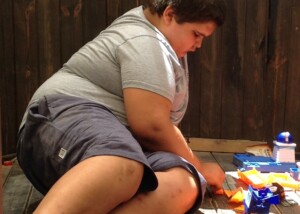Are you autistic, unemployed or have little money and wondering how to get started with an exercise program? You have a built-in gym: your body.
This article, written by a clinically diagnosed Autistic, will come with some bluntness – in true autistic fashion.
And my first straightforward comment is this: Being chronically unemployed or working a low wage job is NO excuse for having poor physical fitness and living on a junk food diet.
Having Autism Spectrum Disorder is NO excuse for neglecting the health and fitness of your body.
- The average life expectancy for those with Level 1 ASD is only 58.
- Level 1 means minimal support needs.
It vexes me to no end how an autistic individual — who may have always felt “cheated” in life due to their difficulties with social navigation – will still refuse to engage in structured body workouts — a venture for which they can be on a level playing field with neurotypicals!
I’m going to explain how an autistic adult can integrate a fitness regimen into their life – even if living below the poverty level; even if struggling to hold down a job; even if you have substantial sensory issues or difficulty with basic human interaction.
However, I also need to point out that many autistic individuals who lead sedentary lifestyles (and thus are in poor physical condition, having a body that resembles that of Homer Simpson or Flabby Flo) – are actually gainfully employed and living fully independent lives.
I’ve not been able to locate a study that shows the average life expectancy of specifically Autistics who have long-term employment.
But I’d imagine that the average life expectancy for Autistics who, for instance, hold teaching jobs, careers in tech and other professional fields, or high-paying labor jobs such as construction, would be a lot higher than 58.
This begs the question: Does employment and its health insurance lead to a longer life?
Or, perhaps it works as follows: An autistic adult who has the cognitive bandwidth to hold down a good job would also more likely possess the bandwidth to place a high value on an exercise regimen and making conscious efforts to adhere to a healthful diet.
- In short, an association between two factors doesn’t always mean causality.
Another intriguing consideration is that having medical coverage is linked to a longer life because it pays for exams such as annual physicals, mammograms and workups for concerning symptoms – which all can lead to an early diagnosis of a serious disease.
- However, having health coverage doesn’t automatically make one’s body physically fit or possessing markers for longevity such as low blood pressure.
- It only gets a disease or condition diagnosed – and treated – sooner. And patient compliance is very important (such as taking blood pressure medication).
You can still be in miserable physical shape despite having the best medical insurance.
Home Gym Workouts with Zero to Minimal Money Investment
Your body is your gym equipment. Bodyweight exercises are a very effective form of weight bearing movements.
You can do modified (beginner) pushups with your hands on the edge of a countertop, the trunk of a car or a ledge outside.

Modified pushup.Freepik
As you get stronger you can try pushups on a lower ledge such as a stair step and work towards full pushups eventually.
A pull-up bar from Amazon costs $20. BUT WAIT – if you can’t do pull-ups, no problem!
Did you know that simply hanging counts as a strength training exercise?
The dead hang, even though you’re not moving, works the back, shoulder, arm and core muscles in an isometric way. See the image below.
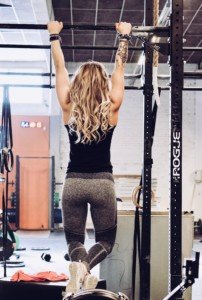
The dead hang. Freepik
Hang for a few seconds to start. Or, hang with your feet barely touching the floor (or small stool) or with only one foot barely touching it – whatever it takes to subtract some body weight from the hang.
Alternate between complete hangs and contacting your feet to the floor, with the goal of increasing the number of seconds hanging until you can hang for 20-30 seconds nonstop.
You can work up to doing “jump pull-ups” by jumping up so that you’re hanging with bent arms, then slowly lower yourself, feet off the floor.

A pull-up or hanging bar is sturdy and will last a very long time — a lot longer than a large pizza. You can build upper body strength by pulling up even if your feet are supported by a small stool, allowing for leg bending with each repetition.
Got some steps or a sturdy short table in your home or live near a park?
You can do dips using the edges of these objects for your shoulders and the backs of your arms (see image below).
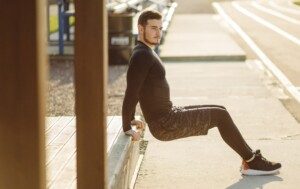
The “bench” dip. Rise up and down by bending the elbows. Make sure that the upper arms do NOT go past parallel to the floor/ground. Freepik/bristekjegor
- Your legs make for fabulous workout equipment.
- Below are images depicting various leg workouts.
- No equipment needed other than your legs!
- You can start with some jumping jacks.
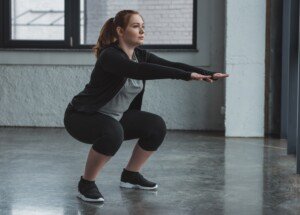
Basic squat. You can hold for extended periods and/or do repetitions. Shutterstock/LightField Studios

The front lunge. You can rise up and down in this same position, or, switch legs after each repetition. You can also do walking lunges.

The side lunge. If you have dumbbells, you can hold them while doing lunges or squats. Freepik.com/diana.grytsku

If you have access to steps, you can jump up them. This is recommended only after you’ve developed some base fitness in your hips and knees. You can also do jumping in place on your living room floor — go for speed or height.
In addition to that $20 pull-up bar (the cost of about four Whopper Combo Meals from Burger King or the low end of a basic manicure), you can purchase a set of tension bands for about $20 from Amazon (see image below).

Anyone can do tension band exercises. The bands are color coded for different levels of resistance.
A dumbbell set costs $37. Give up $37 worth of junk food over 30 days and you have your money for three pairs of dumbbells (see image below).
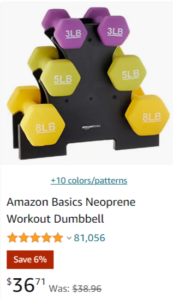
Dumbbells add a whole new dimension to home workouts. Heavier dumbbells do cost more, but even light dumbbells can turn a medium lunge or squat workout into an intense workout. They can also be held while doing fitness walks.
Free delivery of all these products is often an option. Furthermore – and I speak from experience – exercise equipment literally lasts decades.
In fact, you can still be using the equipment you buy today when you’re 90!
Giving up some monthly payments for manicures, hair tint jobs, a new tattoo, new earrings, yet another pair of dress shoes or flashy purse, the new lip color from the Kardashian line, a trip to the movie theatre, a new video game, etc., will easily pay for home exercise equipment that will last for decades.
In fact, giving up a few bags of chips and a few donuts plus a can of soda will pay for a membership at Planet Fitness: just $10 a month!
See the image below. The $49 annual fee equates to $4 per month: half the cost of a pack of cigarettes (quit smoking!); less than the cost of a six-pack of beer; and equal to the cost of three or four candy bars, depending on where you buy them.

Gyms are in competition with each other and thus, are highly motivated to frequently offer great deals to fit even the tightest of budgets. Though this particular deal may no longer be in effect by the time you check it out, there are always deals going on at various gyms.
And by the way, you can also take up brisk walking, some jogging and even buy a jump rope ($9 on Amazon).
What about obesity?
Obesity is so prevalent in the United States, that it’s no surprise that it affects autistic people – but unfortunately, more so than it does neurotypicals.
However, obesity does not prevent weight bearing or cardio exercise!
- Poverty doesn’t cause obesity.
- Overconsumption of food does, especially when coupled with a sedentary lifestyle.
Though there’s an association between poverty and obesity, you must realize that this association does not establish cause-and-effect.
If you look at crowds of people in developing countries, where there is true poverty and food shortages, most have a lean build; very few are obese, let alone morbidly obese.
Spend the same amount of money that you do on junk food on healthy food.
If this means less food, you’ll lose weight: a win-win – save money while losing excess fat.
However, you’d be surprised at the amount of healthy food that comes with the same cost as junk food. See the image below.

There are always deals on healthier food options. The costliest endeavor is a sick body. Source: SparkPeople
I Cringe at Flabby Bodies
No, not “All bodies are good bodies.” This mantra is spoken all over TikTok by morbidly obese influencers, and is also sold on tee shirts. Well, I don’t subscribe to this mantra.
“All bodies are good bodies” has the potential to discourage Autistics (and of course, NTs) from taking seriously the concept of exercise-based and nutrition-based body care.
Though it’s true that there are people (autistic and NT) who, despite “doing everything right,” end up with a serious illness for no known reason, it’s a massive fact of research, science and meta-analytic studies that when a body is trained from structured workouts, and when it’s at a medically acceptable weight and gets fed mostly healthful food — it is FAR MORE LIKELY TO BE STRONG, FREE OF ACHES AND PAINS, FREE OF SICKNESS, FREE OF HAVING TO TAKE MEDICATIONS AND MAKE IT TO RIPE OLD AGE WITHOUT SERIOUS DISEASE.
- It’s just a plain hardcore fact.
- Facts over feelings.
- Research. Facts.
Autism Spectrum Disorder does NOT have to shorten your lifespan or make you physically weak or prone to health ailments!
 Lorra Garrick has been covering medical and fitness topics for many years, having written thousands of articles for print magazines and websites, including as a ghostwriter. She’s also a former ACE-certified personal trainer. In 2022 she received a diagnosis of Level 1 Autism Spectrum Disorder.
Lorra Garrick has been covering medical and fitness topics for many years, having written thousands of articles for print magazines and websites, including as a ghostwriter. She’s also a former ACE-certified personal trainer. In 2022 she received a diagnosis of Level 1 Autism Spectrum Disorder.
.


